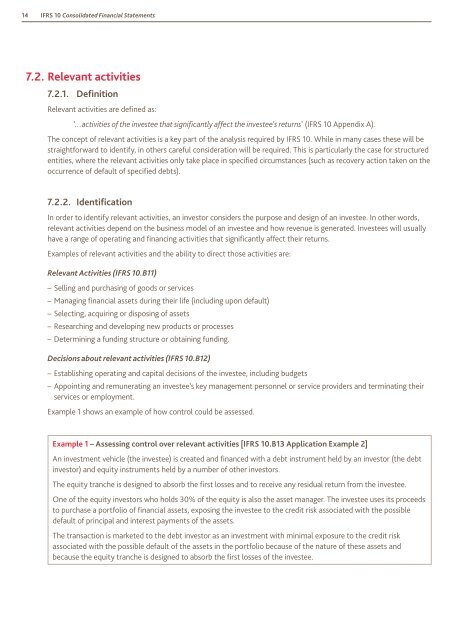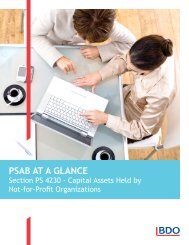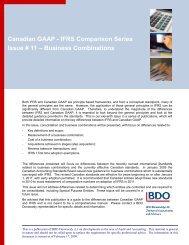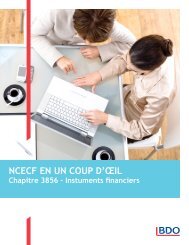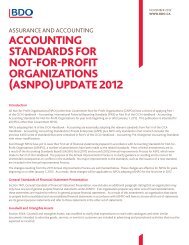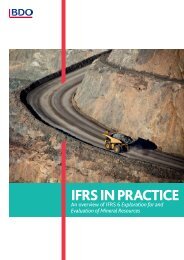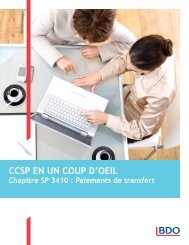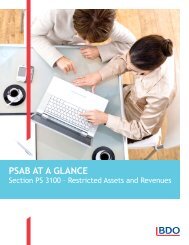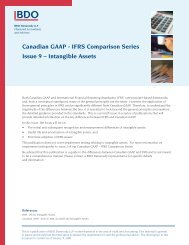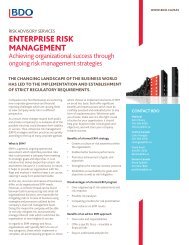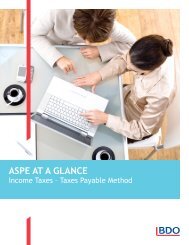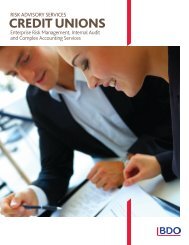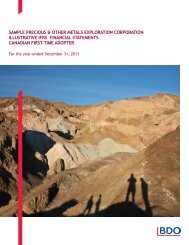Need to Know: IFRS 10 - Consolidated Financial ... - BDO Canada
Need to Know: IFRS 10 - Consolidated Financial ... - BDO Canada
Need to Know: IFRS 10 - Consolidated Financial ... - BDO Canada
- No tags were found...
Create successful ePaper yourself
Turn your PDF publications into a flip-book with our unique Google optimized e-Paper software.
14 <strong>IFRS</strong> <strong>10</strong> <strong>Consolidated</strong> <strong>Financial</strong> Statements7.2. Relevant activities7.2.1. DefinitionRelevant activities are defined as:‘…activities of the investee that significantly affect the investee’s returns’ (<strong>IFRS</strong> <strong>10</strong> Appendix A).The concept of relevant activities is a key part of the analysis required by <strong>IFRS</strong> <strong>10</strong>. While in many cases these will bestraightforward <strong>to</strong> identify, in others careful consideration will be required. This is particularly the case for structuredentities, where the relevant activities only take place in specified circumstances (such as recovery action taken on theoccurrence of default of specified debts).7.2.2. IdentificationIn order <strong>to</strong> identify relevant activities, an inves<strong>to</strong>r considers the purpose and design of an investee. In other words,relevant activities depend on the business model of an investee and how revenue is generated. Investees will usuallyhave a range of operating and financing activities that significantly affect their returns.Examples of relevant activities and the ability <strong>to</strong> direct those activities are:Relevant Activities (<strong>IFRS</strong> <strong>10</strong>.B11)––Selling and purchasing of goods or services––Managing financial assets during their life (including upon default)––Selecting, acquiring or disposing of assets––Researching and developing new products or processes––Determining a funding structure or obtaining funding.Decisions about relevant activities (<strong>IFRS</strong> <strong>10</strong>.B12)––Establishing operating and capital decisions of the investee, including budgets––Appointing and remunerating an investee’s key management personnel or service providers and terminating theirservices or employment.Example 1 shows an example of how control could be assessed.Example 1 – Assessing control over relevant activities [<strong>IFRS</strong> <strong>10</strong>.B13 Application Example 2]An investment vehicle (the investee) is created and financed with a debt instrument held by an inves<strong>to</strong>r (the debtinves<strong>to</strong>r) and equity instruments held by a number of other inves<strong>to</strong>rs.The equity tranche is designed <strong>to</strong> absorb the first losses and <strong>to</strong> receive any residual return from the investee.One of the equity inves<strong>to</strong>rs who holds 30% of the equity is also the asset manager. The investee uses its proceeds<strong>to</strong> purchase a portfolio of financial assets, exposing the investee <strong>to</strong> the credit risk associated with the possibledefault of principal and interest payments of the assets.The transaction is marketed <strong>to</strong> the debt inves<strong>to</strong>r as an investment with minimal exposure <strong>to</strong> the credit riskassociated with the possible default of the assets in the portfolio because of the nature of these assets andbecause the equity tranche is designed <strong>to</strong> absorb the first losses of the investee.


